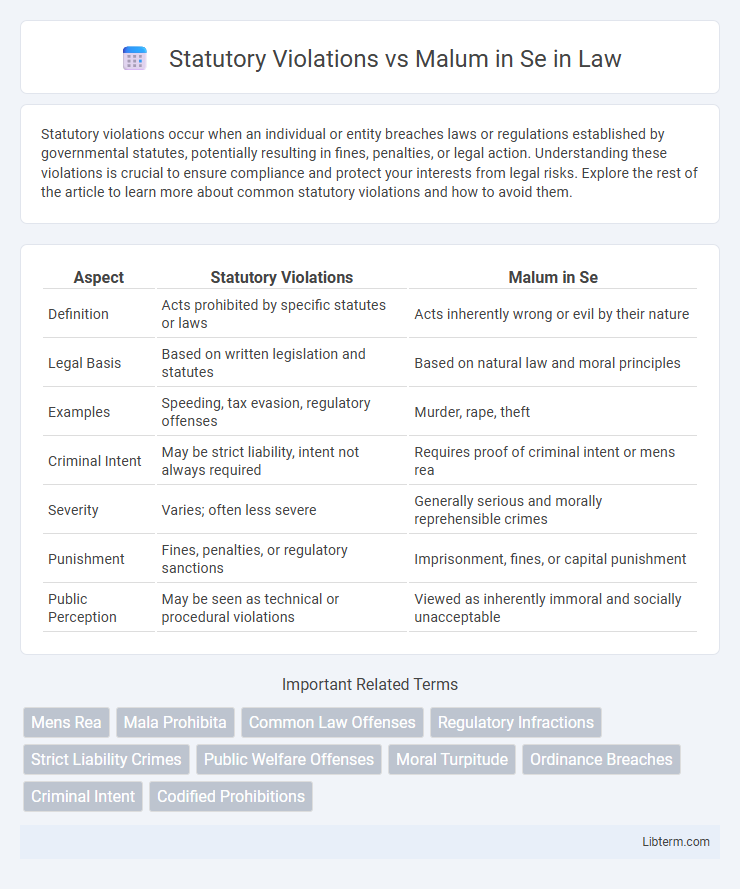Statutory violations occur when an individual or entity breaches laws or regulations established by governmental statutes, potentially resulting in fines, penalties, or legal action. Understanding these violations is crucial to ensure compliance and protect your interests from legal risks. Explore the rest of the article to learn more about common statutory violations and how to avoid them.
Table of Comparison
| Aspect | Statutory Violations | Malum in Se |
|---|---|---|
| Definition | Acts prohibited by specific statutes or laws | Acts inherently wrong or evil by their nature |
| Legal Basis | Based on written legislation and statutes | Based on natural law and moral principles |
| Examples | Speeding, tax evasion, regulatory offenses | Murder, rape, theft |
| Criminal Intent | May be strict liability, intent not always required | Requires proof of criminal intent or mens rea |
| Severity | Varies; often less severe | Generally serious and morally reprehensible crimes |
| Punishment | Fines, penalties, or regulatory sanctions | Imprisonment, fines, or capital punishment |
| Public Perception | May be seen as technical or procedural violations | Viewed as inherently immoral and socially unacceptable |
Defining Statutory Violations
Statutory violations are offenses defined explicitly by legislative statutes, detailing prohibited conduct and corresponding penalties. These violations differ from malum in se crimes, which are inherently wrong by nature, such as murder or theft, regardless of written law. Understanding statutory violations requires examining the specific legal codes that prescribe actions deemed unlawful by the government.
Understanding Malum in Se Offenses
Malum in se offenses are crimes that are inherently wrong or evil by their very nature, such as murder, rape, and theft, reflecting universal moral condemnation. These offenses differ from statutory violations, which are prohibited strictly by law and may not be inherently immoral, like traffic infractions or licensing breaches. Understanding malum in se offenses is crucial for legal interpretation because they require no statutory basis for criminality, relying instead on fundamental moral principles embedded in criminal law.
Legal Foundations: Statutory Law vs. Natural Law
Statutory violations arise from breaches of laws explicitly enacted by legislative bodies, reflecting legal foundations rooted in statutory law, which prescribes clear, codified rules and penalties. In contrast, malum in se offenses are inherently wrong acts recognized through natural law principles, based on moral and ethical standards considered universally unacceptable regardless of written statutes. Understanding the distinction between statutory law and natural law is crucial for interpreting legal culpability and the basis for criminal liability in different jurisdictions.
Key Differences Between Statutory Violations and Malum in Se
Statutory violations refer to offenses that breach specific laws or regulations enacted by legislative bodies, whereas malum in se crimes are inherently wrong or evil by their very nature, such as murder or theft. Statutory violations are defined by written codes and often carry varying penalties contingent on legal statutes, while malum in se offenses carry universal moral condemnation regardless of statute. Understanding the distinction centers on the source of wrongdoing: statutory violations derive their illegality from explicit laws, whereas malum in se offenses are violations of natural or moral principles recognized across cultures.
Examples of Statutory Violations
Examples of statutory violations include traffic offenses like speeding, selling alcohol to minors, and tax evasion, all of which breach specific laws established by legislative bodies. These violations differ from malum in se crimes, such as murder or theft, which are inherently wrong by moral standards and common law precedent. Statutory violations are often regulatory or administrative in nature, with penalties defined explicitly by statutes.
Classic Examples of Malum in Se Crimes
Classic examples of malum in se crimes include murder, rape, and theft, offenses universally condemned due to their inherently immoral nature. These acts violate fundamental ethical principles and are punishable regardless of statutory frameworks, contrasting with statutory violations which depend solely on legislative enactments. Understanding malum in se helps distinguish deeply egregious offenses from malum prohibitum, enhancing legal clarity in criminal law.
Purpose and Intent Behind the Laws
Statutory violations are breaches of laws enacted by legislatures with the primary purpose of maintaining public order and safety through clear, specific prohibitions. Malum in se offenses are inherently wrong actions, such as murder or theft, recognized universally based on moral principles and societal consensus. The intent behind statutory laws is often preventive and regulatory, while malum in se laws focus on condemning morally reprehensible conduct regardless of written statutes.
Penalties and Legal Consequences
Statutory violations involve breaches of laws enacted by legislative bodies, resulting in penalties such as fines, license suspensions, or community service depending on the statute's severity. Malum in se offenses, recognized as inherently evil acts like murder or theft, carry harsher legal consequences including imprisonment or capital punishment due to their fundamental immorality. Courts typically impose stricter sentences for malum in se crimes reflecting society's condemnation, whereas statutory violations may receive more variable penalties aligned with regulatory objectives.
Judicial Interpretation and Enforcement
Judicial interpretation distinguishes statutory violations, which breach specific laws enacted by legislatures, from malum in se offenses, inherently immoral acts recognized by common law, influencing enforcement priorities. Courts often apply stricter scrutiny and harsher penalties to malum in se crimes due to their intrinsic wrongfulness, while statutory violations may involve regulatory or procedural breaches with varying degrees of severity. Enforcement agencies prioritize malum in se offenses to uphold fundamental societal norms, whereas statutory violations are frequently addressed through administrative or corrective measures.
Societal Impact and Moral Considerations
Statutory violations refer to offenses that breach specific laws enacted by legislatures, affecting societal order through codified rules and regulations. Malum in se offenses, inherently immoral acts like murder or theft, evoke universal condemnation due to their violation of fundamental ethical principles and natural justice. The societal impact of statutory violations varies by law, while malum in se crimes consistently undermine social trust and moral cohesion, emphasizing the intrinsic link between law and ethics.
Statutory Violations Infographic

 libterm.com
libterm.com